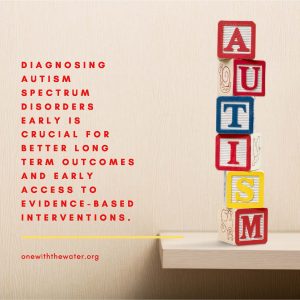The rates of Autism are climbing in the U.S., and recent studies are finding that diagnosing autism spectrum disorders early is vital for many important reasons, including better long term outcomes and early access to evidence-based interventions. [1]
A study published by JAMA Pediatrics in April of this year found that Autism Spectrum Disorders can be diagnosed as early as 12 months old, and when re-evaluated at age three, 84% of children diagnosed around the 14th-month marker retained the diagnosis.
According to co-author Dr. Karen Pierce, a professor in the department of neurosciences, and co-director at the Autism Center, University of California, San Diego,
“Diagnosing autism spectrum disorders early is extremely important because the brain is really plastic during early development. If you can identify and start treating autism spectrum disorders before those connections are made, maybe more effective connections will be made. … We believe from a neuroscience perspective; kids will have better outcomes.”[2]
 The immediate takeaway in all of this is that parents should raise any concerns they have with their doctor at any age. You are your child’s best advocate, and you are uniquely positioned to observe them in their natural environment for extended periods. If you aren’t sure or have concerns on where to start, consider these five questions, developed by Dr. Connie Kasari, (professor of human development and psychology in the UCLA Graduate School of Education and Information Studies and the Semel Institute of Neuroscience and Human Behavior) as a means of determining early warning signs of autism and autism spectrum disorders.
The immediate takeaway in all of this is that parents should raise any concerns they have with their doctor at any age. You are your child’s best advocate, and you are uniquely positioned to observe them in their natural environment for extended periods. If you aren’t sure or have concerns on where to start, consider these five questions, developed by Dr. Connie Kasari, (professor of human development and psychology in the UCLA Graduate School of Education and Information Studies and the Semel Institute of Neuroscience and Human Behavior) as a means of determining early warning signs of autism and autism spectrum disorders.
- Does the baby respond to his or her name when called by the caregiver? Neurotypical children will react to the sound of their name by turning toward the person who called out. Babies with Autism don’t typically respond and often have a selective response to sound.
- Does the young child engage in “joint attention”? Joint attention is simply when a child joins with the person engaging them to look at the same item or focus on the same activity. I.E., shifting their gaze when prompted, looking in the direction of a pointed finger, etc.
- Does the child imitate others? Babies with autism display mimicking behavior (like sounds, waving, clapping, and facial expressions) at significantly fewer rates than neurotypical children. In fact, it is critical to understand with all of these behaviors that the primary concern is the total absence or extremely low frequency of occurrence of the behavior.
- Does the child respond emotionally to others? Neurotypical babies are emotionally reactive, smiling, laughing, etc., and will usually mirror and mimic the emotions of those around them.
- Does the baby engage in pretend play? (This behavior usually develops close to the end of year two, and a child with Autism may not engage with toys at all, or they may develop obsessive relationships with one toy to the exclusion of all others, or even just with the movement of their own body.)[3]
If any of these questions trigger a red flag, don’t be afraid to dig deeper, knowing that early intervention can create better long-term outcomes for a potentially neuro-diverse child.
Finally, if you currently have a child on the autism spectrum, then consider swim lessons as one of the early therapeutic interventions known to have measurable positive results for your child, as well as the number one tool to significantly decrease their risk of drowning. Register today to find out more!
[1] https://pediatrics.aappublications.org/content/136/Supplement_1/S60
[2] http://healthinfo.uclahealth.org/yourfamily/children/NewsRecent/6,745624
[3] https://www.uclahealth.org/five-early-signs-of-autism
Molly is a member of our creative team, mom of four water-loving babies, and a fierce advocate for CPR training and really early swim instruction.
